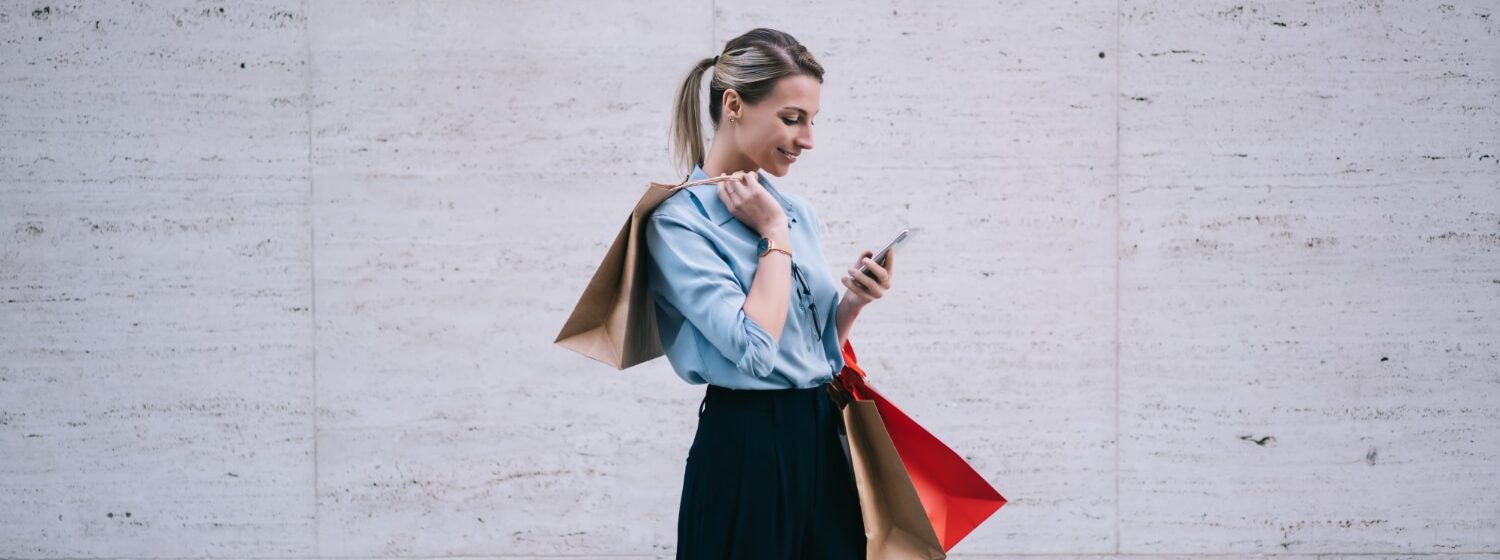This week’s post features our special guest, Miriam Lahage. Miriam was formerly the CEO of FigLeaves.com, plus a VP at eBay, Net-a-Porter and TJ Maxx (TK Maxx in the UK). She has been involved in Ecommerce since the beginning of the early 2000s. Miriam is now the co-founder of Aequip, which helps companies to reduce staff turnover and increase workforce morale.
What would you say is the biggest change in how people shop online?
When I think about it from a fashion perspective, the conventional wisdom was that people wouldn’t buy fashion online because you couldn’t touch the merchandise. Now the irony is that you can’t touch the merchandise in the store right now (because of COVID-19).
One barrier was that the online experience produced friction – everyone needed to learn how to shop. And that has certainly changed. People have found the places that they want, to get their evergreen products, online.
Customers are now open to discovery, much like browsing a shop. The browsing happens inside their consideration set of a few shops online or offline. But now it’s often likely to happen by visiting a new shop from Instagram or TikTok. Discovery of new brands and new business models like Thread, where a stylist custom picks the merchandise and sends it to your door. I think it opens the world up more to customers.
Is it easier or harder to launch a new Ecommerce business these days?
There’s more competition than there was before, but back then, there were bigger tech barriers. You really needed to have technical chops, in order to make sure you were doing the right thing.
Now, the tech is much easier, but there’s greater competition with tools like Shopify, WooCommerce, Magento, even plugins for absolutely every need that you have. Tech has gotten much, much easier. You can punch above your weight with intuitive, no-code tools. Ecommerce tech is really no longer a barrier to starting out, but it used to be.
We used to say when a website launched, congratulations! But now, the hard work starts when the website starts trading. In the past, without as much competition, trading was a bit easier than it is today.
If you’re in a niche business with a clear customer value proposition, you can thrive. I think of Wild Swans, which sells Danish designer clothing, curated here in London. They can thrive in their niche and are selling across the world. But if you’re an also-ran shop, that offers what everyone else sells, you can’t compete for market share. And it’s very difficult for them to trade online.
How has the internet and buying online, changed the fashion industry as a whole?
One of the companies that I worked with was Net-a-Porter. They were really defined for getting editorial content into the shopping experience. And that was a fundamental change for Ecommerce and a fundamental change for fashion in general.
Designer collaborations, which we pioneered while I was at eBay, democratized fashion pieces. It considered design for a broader group of people. People forget, but it used to be that the catwalk happened and then a year later, everyone would be able to buy the knockoffs of that merchandise. Now everyone can watch the runway shows – not just the elite few. The fashion moves from the runway to the street, much faster than it used to. I guess the other piece would be the internationalization of brands. A decade ago at Net-a-Porter, we would have more inbound searches for Diane Von Furstenberg and other US brands, from the UK, and more inbound searches for Alexander McQueen (a UK brand), from the US. Borders are now porous and fashion brands can lean into the natural customer demand, wherever it originates.
What are the Ecommerce brands that you respect? Are there any new brands or innovations that impress you?
I’ve been impressed with smaller brands that have found a great niche.
END Clothing is a menswear brand based in the North of England. They carry the major brands, but they also carry a curation of special collections from those brands.
I love Sneakersnstuff. It was started by Swedish sneakerheads and has a beautiful shop, both offline and online. They carry upcoming releases. There are raffles to buy items that are new in their collections. They capture the excitement of the sneakerheads, those real serious sneaker fans, who queue up outside a shop. Their ecommerce site brings the brand to life.
I also like the “circular economy” model, such as thredUP, which is from the US and founded by Harvard Business School grads. They’ve redefined the Used Clothing market in the US, and that has gained traction all over the world. The circular economy model is one that, along with off-price, I think can thrive online.
Will the High Street / Main Street stores survive, as Ecommerce gets more popular?
I don’t think anyone would argue with me that the US and the UK are overstored. We have far too many stores and far too much merchandise. And where will it all go? At a time like this, it just proves that the reduction in customer numbers allowed into stores, makes the unit economics of stores unsustainable with high rents.
I believe there’s an opportunity to do some data-led analysis of shops within a radius of customer homes, and that should drive store portfolio decisions. The local main street or high street will be the future, rather than big expensive flagship stores, with limited stock and full selection. Ecommerce will see the growth, as we right-size the store portfolios. There will be a very different way of thinking about our store portfolios for the future.
How important was SEO to each of the brands that you’ve worked with?
SEO has always been under-appreciated and almost always underfunded. I think that’s because the lead time to see results from SEO can be very long and why we don’t pay enough attention to it. It’s a slow build – like watching paint dry.
It feels like sorcery to most of the fashion business. So finding ways for people to understand why it matters is key. Every pound we spend in getting on a good SEO path right now, means that we don’t have to spend £10 trying to attract a customer with PPC over and over and over.
I believe SEO needs an owner in the business and supporting roles from technology, content creation, and marketing – because all of them have a part to play. I myself have been lucky to work with brilliant SEO experts over the years. You know that they’re the SEO experts because they’re the first ones to say that they’re not experts. If you get interested in SEO and you’re looking for help, do your due diligence. Follow them on Twitter, get recommendations from a few people you respect – it really is still the wild west out there, full of self-identified SEO gurus. There are people out there who will shamelessly take the real SEO expert’s work and pass it off as their own. I’m happy to share with anyone who wants to talk to me, about what that wild west is like.
If you started a new online fashion store this year, what would be your SEO strategy?
I would start with the fundamentals, understanding who your customer is and understand when and what’s important to them and where they congregate online. It can help in terms of content creation and should help with SEO. It really is a holistic approach – set up your stall so that you’re positioned with good tools, and getting good advice is key. Recognize that it’s better to launch correctly and take the time needed to think about structure prelaunch, rather than rushing into something and then having to redo the structure.
If you can leverage your SEO, spend to drive at least half your overall revenue from organic search – your unit economics get infinitely easier. Rather than thinking of your SEO budget as a percentage of marketing spend, which I actually don’t do, I would think of the goal like training for a marathon – put the miles in early, and it will more than pay off later.
Do you think that Google has grown too big?
I am old enough to remember seeing Google when it first launched. The dad of Instagram co-founder, Kevin Systrom, showed it to me over 20 years ago. I said, “this looks great, but how are they going to make money?”. I didn’t realize they would have so much of my money in the end.
They are probably too big and one product/source is probably not right for everyone in the marketplace of ideas. There’s definitely a business model for another strong player, that meets the needs of many. We’re not thrilled with using Google. I support “Contract for the web“, a Tim Berners-Lee initiative, to hold governments, companies and citizens accountable. The privacy guidelines are worthwhile exploring. And I think about Google when I look at that.
Are you disturbed by how Ecommerce adverts follow you around the internet?
The choices I make online and offline lead to outcomes. If every time I go to a shop, I buy black shoes (which I do), I would hope that they would show me the newest black shoes next time I visit. Shouldn’t it be the same online? So, where is the line? I guess, when it’s not relevant, I do get annoyed. When I’ve made a one-off purchase and that follows me around. I’ve bought a washing machine from you, why are you trying to sell me another one?
You see it so often, don’t you? It’s crazy!
What is your new start-up, Aequip, all about?
Aequip helps increase innovation in businesses, by reducing organizational friction and ensuring that every voice is included by design. We do this using behavioral science and data science with an anonymous double feedback loop.
Do you think that some larger Ecommerce brands are starting to feel growing pains as businesses?
Ecommerce growth was fueled by venture capital. You fund customer acquisition at a loss. You basically buy that customer’s business. We’ve seen a shift recently to an operational mindset, refining the unit economics to drive a path to profitability. It takes a different mindset and different skills, and definitely Aequip can help with that.
Would you ever return to Fashion Ecommerce?
I still advise a few Ecommerce brands. I still shop stores. Once a retailer, always a retailer! I’ve had three discussions just this week, on how to help retail brands grow their brands.
Thank you for being on this week’s post, Miriam!





